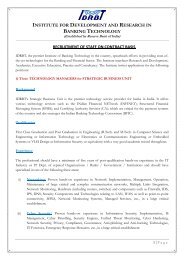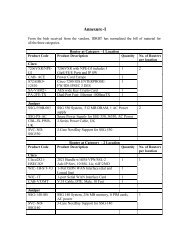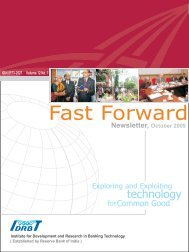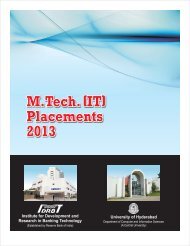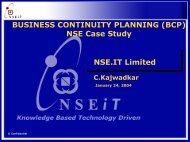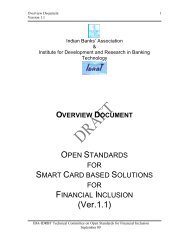Technology in Banking-Insight and Foresight for BTA_2011 ... - IDRBT
Technology in Banking-Insight and Foresight for BTA_2011 ... - IDRBT
Technology in Banking-Insight and Foresight for BTA_2011 ... - IDRBT
Create successful ePaper yourself
Turn your PDF publications into a flip-book with our unique Google optimized e-Paper software.
<strong>Technology</strong> <strong>in</strong> Bank<strong>in</strong>g – <strong>Insight</strong> & <strong>Foresight</strong> 26<br />
For mobile payments to even remotely become a substitute <strong>for</strong> liquidity (cash), the key is a wide<br />
acceptance network. This is the real anchor of the value proposition <strong>for</strong> mobile bank<strong>in</strong>g customers.<br />
To derive maximum value from remote transactions, us<strong>in</strong>g the cell phone just like an <strong>in</strong>ternet<br />
term<strong>in</strong>al, beg<strong>in</strong>s with gett<strong>in</strong>g people to leave more cash <strong>in</strong> their accounts. This may happen when<br />
people see that there are many ways <strong>in</strong> which they can cash out. Once that network is established,<br />
the value of transact<strong>in</strong>g remotely may become more apparent.<br />
Banks that want to use mobile bank<strong>in</strong>g to reach unbanked customers need access to market<strong>in</strong>g<br />
channels <strong>and</strong> br<strong>and</strong> credibility with precisely those customers who have been excluded from<br />
bank<strong>in</strong>g. Unlike most banks, mobile operators traditionally use a mass-market approach <strong>and</strong> aim to<br />
get <strong>in</strong>to the pocket of every citizen <strong>in</strong> the <strong>for</strong>m of mobiles.<br />
Mobile applications-based bank<strong>in</strong>g is poised to emerge as a significant m-commerce feature, <strong>and</strong> if<br />
South Africa’s <strong>for</strong>ay <strong>in</strong>to mass mobile bank<strong>in</strong>g is any <strong>in</strong>dication, mobile bank<strong>in</strong>g could well be the<br />
driv<strong>in</strong>g factor to <strong>in</strong>crease the sales of high-end mobile phones. Nevertheless, banks need to take a<br />
hard <strong>and</strong> deep look <strong>in</strong>to the mobile usage patterns among their target customers <strong>and</strong> enable the<br />
requisite technology on their mobile services to reach out to the majority of their customers. Mobile<br />
bank<strong>in</strong>g is slated to get big <strong>in</strong> terms of volumes <strong>and</strong> value; it is projected to drive the f<strong>in</strong>ancial<br />
revolution at the bottom of the pyramid. However, the times ahead will <strong>in</strong>dicate whether the banks<br />
will ascend toward f<strong>in</strong>ancial strength over mobiles or a new ecosystem would emerge compris<strong>in</strong>g<br />
various stakeholders to tap the hidden potential of mobile bank<strong>in</strong>g.<br />
3.3. Electronic Payments<br />
Payments are an age old phenomena that have been with human be<strong>in</strong>gs s<strong>in</strong>ce ages. We have<br />
certa<strong>in</strong>ly evolved, hav<strong>in</strong>g come a long way from the barter system to written promises such as notes<br />
to quite recently adopted electronic payments.<br />
3.3.1. Evolution of Electronic Payments <strong>in</strong> India<br />
The electronic payments <strong>in</strong> India have evolved steadily over the past few years. The first big leap<br />
came <strong>in</strong> the late 1990s with the growth of the ECS debit <strong>and</strong> credit transaction, then came the rise of<br />
<strong>in</strong>ternet bank<strong>in</strong>g <strong>in</strong> the early 2000s <strong>and</strong> the <strong>in</strong>troduction of RTGS <strong>in</strong> 2004 <strong>and</strong> NEFT <strong>in</strong> 2005. Recent<br />
years have seen the rise of newer channels such as prepaid <strong>in</strong>struments <strong>and</strong> mobile phones. While<br />
the traditional cash-based <strong>and</strong> paper-based channels cont<strong>in</strong>ue <strong>in</strong> the retail space, electronification<br />
has demonstrated significant progress <strong>in</strong> these years.<br />
3.3.2. Overview of Electronic Payments Markets globally <strong>and</strong> <strong>in</strong> India<br />
The total turnover of various payment <strong>and</strong> settlement systems <strong>in</strong> India grew by 16% <strong>in</strong> value<br />
terms <strong>in</strong> 2009–10. The annual turnover <strong>in</strong> payment systems has been <strong>in</strong>creas<strong>in</strong>g as a ratio of<br />
GDP, consistent with the f<strong>in</strong>ancial deepen<strong>in</strong>g of the economy.<br />
In 2010, India’s electronic payments were US$17 trillion (INR786trillion). In 2009, McK<strong>in</strong>sey<br />
estimated India’s payments <strong>in</strong>dustry revenues at US$14 billion. Payment flows (both<br />
electronic <strong>and</strong> paper) are 7.8 times the GDP, comparable to many Western countries <strong>and</strong><br />
emerg<strong>in</strong>g economies such as Brazil (7.3), Italy (7.2) <strong>and</strong> the US. (7.0).<br />
Institute <strong>for</strong> Development & Research<br />
<strong>in</strong> Bank<strong>in</strong>g <strong>Technology</strong>





